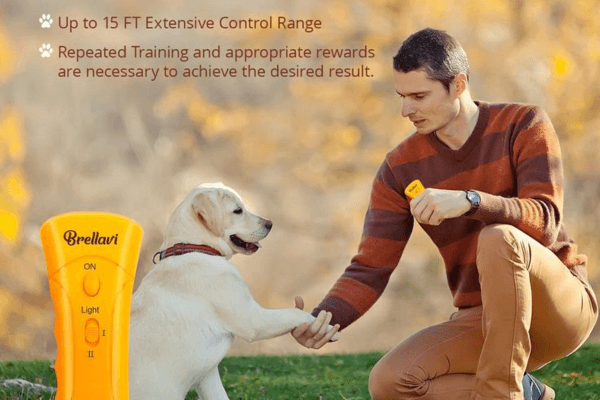In recent years, the issue of excessive barking in dogs has become a concern for many pet owners. This behavior can not only be disruptive and irritating, but it also has the potential to cause stress and annoyance to neighbors. As a result, there has been an increase in the demand for anti-barking devices that aim to address this problem.
Anti-Barking Device comes in various forms, ranging from ultrasonic and vibration collars to citronella sprays and remote control trainers.
The purpose of this article is to provide an overview of different types of anti barking devices available on the market today. It will explore how these devices work, discuss factors that should be considered when choosing one, offer training tips for their effective use, and debunk common myths and misconceptions surrounding them.
By examining both the benefits and limitations of these devices, readers will gain a comprehensive understanding of their potential usefulness in managing excessive barking behaviors in dogs.
Key Takeaways
- Anti-barking devices are designed to address excessive barking in dogs and provide relief to pet owners and neighbors.
- There are three main types of anti barking devices: ultrasonic bark control collars, citronella spray collars, and vibration collars.
- Each type of device has its pros and cons, including effectiveness, potential discomfort or aversion for the dog, and suitability for specific needs such as hearing impairment.
- It is important to consider the dog’s temperament and needs, research and compare effectiveness, and understand that anti barking devices should not replace proper training and socialization.
Types of Anti-Barking Devices
There are several distinct types of anti-barking devices available on the market. These devices aim to control excessive barking in dogs, providing a solution for owners seeking peace and tranquility.
One type of anti-barking device is the ultrasonic bark control collar, which emits high-pitched sounds to deter dogs from barking. This type of device is effective in training dogs to reduce their barking behavior but may cause discomfort or anxiety in some animals.

Another popular option is the citronella spray collar, which releases a burst of citronella scent when triggered by barking. While this type of device is generally safe and effective, it relies on the dog’s aversion to the smell and may not work for all individuals.
Additionally, there are vibration collars that deliver gentle vibrations when activated by barking. These collars can be helpful for deaf or hearing-impaired dogs but may not be as effective for others.
Each type of anti-barking device has its own pros and cons, and choosing the most suitable one depends on factors such as the dog’s temperament and individual needs.
How Anti-Barking Devices Work
One might be surprised to learn the intricate mechanisms by which these noise-suppressing tools operate. Anti-barking devices employ various methods to address excessive barking in dogs. These devices often utilize ultrasonic sound or vibrations to deter dogs from barking excessively.
Advantages of using anti-barking devices include their ability to provide a consistent and immediate response to barking, helping to train dogs and promote more desirable behavior. Furthermore, they can be used as a tool for owners who are unable to consistently address their dog’s barking due to busy schedules or other commitments.
However, it is important to consider potential side effects of using anti-barking devices. Some dogs may become desensitized over time, rendering the device less effective. Additionally, there is a risk that these devices could cause anxiety or distress in sensitive dogs if not used properly or if the intensity level is too high.
Overall, understanding how anti-barking devices work can help individuals make informed decisions about whether they are suitable for their specific situation and canine companion.
Factors to Consider When Choosing an Anti-Barking Device
When selecting a tool to address excessive canine noise, it is crucial to take into account various factors that can influence the effectiveness and suitability of the chosen method.
One important factor to consider is the effectiveness of anti-barking devices. Different devices may use different methods to deter barking, such as emitting ultrasonic sound or producing vibrations. It is essential to research and compare the effectiveness of these devices before making a purchase.
Another factor to consider when choosing an anti-barking device is the cost comparison of different options. There are a wide range of devices available on the market, each with varying price points. It is important to evaluate whether the cost aligns with your budget and if it provides good value for money. Additionally, consider any additional costs associated with maintenance or replacement parts.
By considering both the effectiveness and cost comparison of different anti-barking devices, you can make an informed decision that best suits your needs in addressing excessive canine noise.
Training Tips for Using Anti-Barking Devices
To effectively integrate and maximize the benefits of anti-barking devices, it is essential to follow proper training techniques that promote positive reinforcement and consistency in behavior modification.

Dog behavior modification requires a systematic approach that focuses on reinforcing desirable behaviors rather than punishing undesirable ones. Positive reinforcement techniques, such as rewarding the dog with treats or praise when they remain quiet, can be highly effective in teaching them alternative behaviors.
Consistency is also crucial in training dogs to respond appropriately to anti-barking devices. This involves using the device consistently whenever barking occurs and ensuring that all members of the household are consistent in their response.
By employing these strategies, dog owners can create an environment that encourages positive behavior and reduces excessive barking through the use of anti-barking devices.
Common Myths and Misconceptions about Anti-Barking Devices
Despite their popularity, there are several widespread misconceptions surrounding the effectiveness and ethical implications of using devices aimed at curbing excessive dog vocalization.
One common myth is that anti-barking devices are universally effective in stopping dogs from barking. While these devices may be successful for some dogs, their effectiveness can vary depending on individual temperament and training methods used. It is important to note that anti-barking devices should never be seen as a substitute for proper training and socialization.
Another misconception is that these devices have no potential side effects. However, some dogs may experience adverse reactions such as anxiety, fear, or aggression when exposed to these devices. Additionally, prolonged or improper use of anti-barking devices can lead to desensitization, where the dog becomes immune to the device’s stimuli.
To ensure the well-being of our furry companions, it is crucial to consider alternative methods such as positive reinforcement training and addressing any underlying issues causing excessive barking before resorting to anti-barking devices.
See Also:
- Dogs Day Out: The Best Way to Give Your Dog a Break
- Brunch Dog Friendly
- Welcome To My Dog Store
- Car Seat Booster For Dogs
Conclusion
Anti-barking device can be an effective tool to manage excessive barking in dogs. However, its success depends on proper usage, training, and considering the individual needs and temperament of the dog.
As with any training aid, it’s essential to use it responsibly and with humane intentions to ensure the well-being and happiness of your furry companion. Consulting a professional dog trainer or behaviorist can be beneficial in implementing such devices appropriately.
Why not consider introducing a new member into your family? With adoption, you’re rescuing a life and enriching your own. Show your compassion, make a difference, and start your exciting journey toward adopting a loving companion today.
Visit Bone Voyage Dog Rescue, where love and second chances are just a click away. Because every pup deserves a home
Frequently Asked Questions
Can I use an anti-barking device on any breed of dog?
The effectiveness of anti-barking devices on different dog breeds varies. Factors to consider when choosing a device for your dog include breed characteristics, temperament, and the type of barking exhibited.
How long does it take for an anti-barking device to show results?
The time it takes for training techniques to reduce barking in dogs varies depending on the individual dog and the consistency of the training. Alternatives to using an anti-barking device include positive reinforcement, behavior modification, and professional help.
Are anti-barking devices safe to use around children and other pets?
Using an allegory, it is imperative to discuss potential side effects of anti-barking devices on children and pets. Additionally, exploring alternative methods for managing excessive barking around them is crucial in serving their well-being.
Can an anti-barking device cause harm or discomfort to my dog?
Harmful effects of certain devices on dogs include discomfort, anxiety, and potential hearing damage. Alternative solutions such as positive reinforcement training and addressing underlying causes of barking should be considered to ensure the well-being of the dog.
Can I use an anti barking device indoors and outdoors?
Using an anti barking device both indoors and outdoors can be highly effective in curbing excessive barking. Its versatility allows for consistent training, ensuring the reduction of noise disturbances and promoting a peaceful environment for all.
